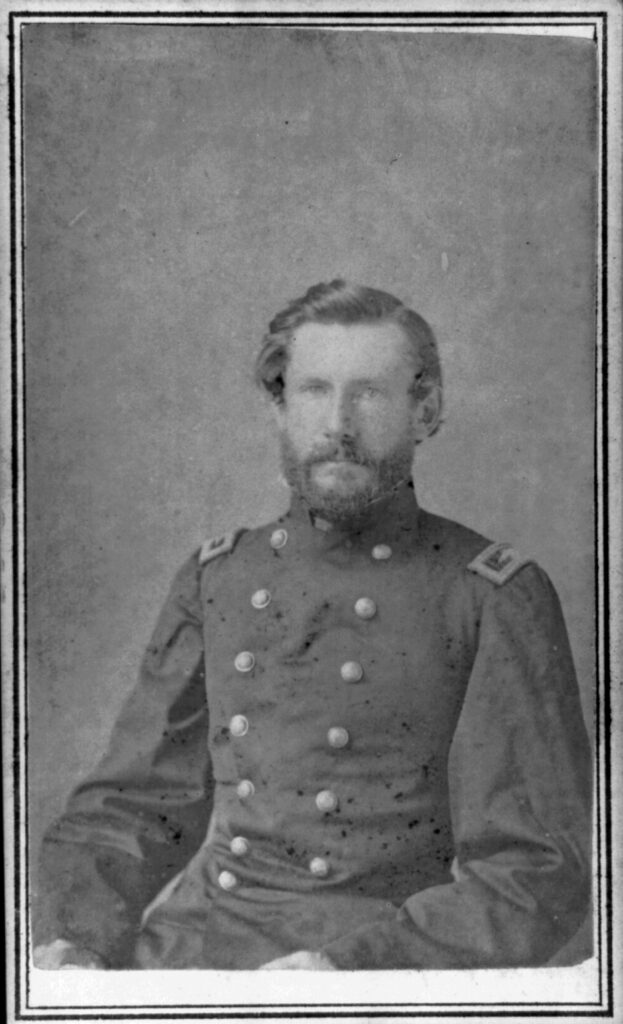
Pre-War Biography
Albert Myer was born on September 20, 1828 to Henry Beekman Myer and Eleanor Pope McClanahan. His family moved to Buffalo in 1835, and his mother died shortly after moving there. After this, his father left him in the care of his aunt, Serena McClanahan. Myer attended Geneva College (now known as Hobart College). He graduated with a Bachelor’s degree in August 1847. Sometime between 1847 and 1850, Myer began to study medicine and work at a local telegraph office. This would be his first experience with the telegraph, and it would influence the rest of his life. He graduated from the University of Buffalo medical school in February 1851. His thesis was entitled “A New Sign Language for Deaf Mutes.” In his thesis, Myer wanted to adapt a telegraph alphabet, similar to Morse Code, to an alphabet of tapping. This would allow a deaf person to communicate by tapping a table or in someone else’s palm. This idea would eventually evolve into the communication system that Myer developed using flags.
He spent the next two years in Charleston, SC and Jacksonville, FL practicing medicine. Afterwards, he passed the Army’s medical examination on Jan. 17, 1854. He was commissioned into the Army on Sep. 24, 1854 as an Assistant Surgeon with the rank of First Lieutenant. He was sent to Texas for his first assignment. He would spend the next three years there. During this time, Myer served as post surgeon for forts in the area. While in Texas, Myer spent his time doing routine physical examinations, surgery when required, and taking weather observations. Additionally, he was fascinated by the potatoes in the region. He left Texas in July 1857. He married Katherine Walden on August 24, 1857.
In October 1856, Myer sent a letter to Secretary of War Jefferson Davis about developing a system of signals for use in the Army. The idea did not interest Davis, but the next Secretary of War, John B. Floyd, was interested. Floyd gave Myer permission to develop his system. Myer lived in Buffalo for the rest of 1857 and almost all of 1858 developing his system. Myer presented his system to an Army board in March 1859. The board produced a favorable report. Myer used the rest of 1859 to test his signals at Ft. Monroe and at various locations in New York harbor. While testing, Myer was helped by many officers, including 2nd Lt. Edward Porter Alexander of the Engineers (future founder of the CSA Signal Corps as well as James Longstreet’s chief of artillery).
System of Signals
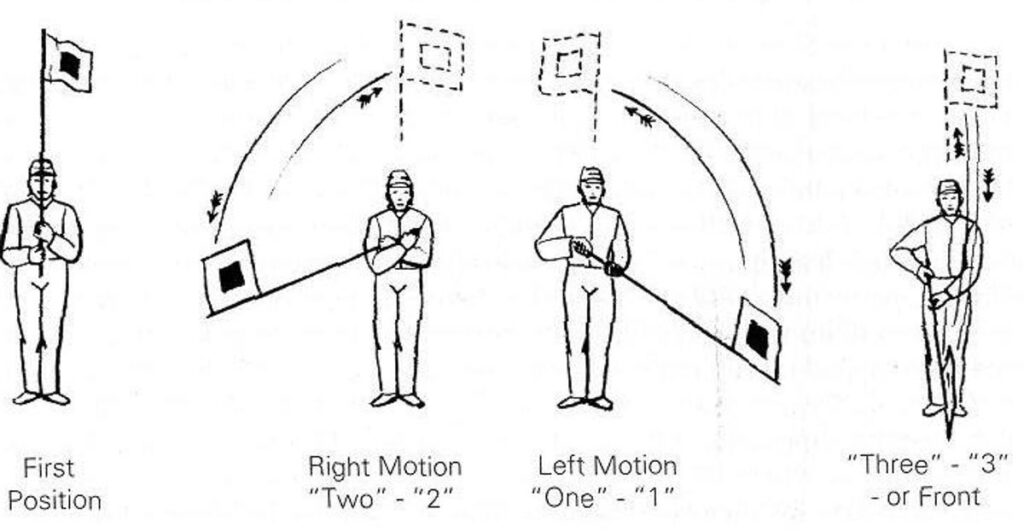
Myer’s based his system of visual signals on telegraphic alphabets, like Morse code. For his system, a flagman would hold the flag in the vertical position. If they went left, then back to the vertical, that would be known as a “1” motion. If they went right and back to the vertical, it would be a “2” motion. If lowered the flag in front of them, then back to the vertical, it would be a “3” motion. In this system, letters would be represented by a combination of 1’s and 2’s. For example, A is represented by 12. To make this motion, the flagman would first make a 1 motion to the left, then they would pass the vertical position. They would go to the right to make a 2, then return to the vertical. There would be no pause between the 1 and 2 signal, and that is how this would be known to be a single letter. This process would be done with flags during the day, and torches at night. Because of the motion of the flags, it became known as the “wig-wag” system.
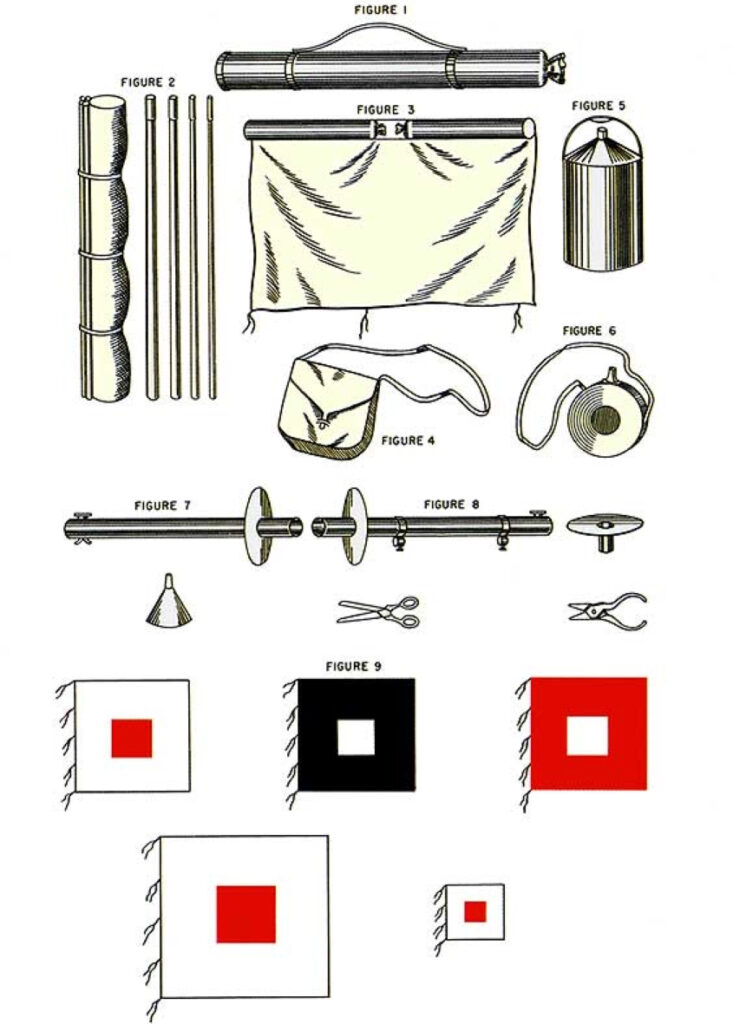
A standard signal kit would contain all the equipment for the flags and torches. The flags came in three different sizes: 2’x 2’, 4’x 4’, and 6’x 6’. The 2’x 2’ flag was used for sending signals in campaign circumstances when the distance is not very great. The 4’x 4’ flag was the standard flag that would be used, and when needed for long distances, the 6’x 6’ flag would be used. The flagpole was 16’ in length, and broken up into 4’ sections. Additionally, there were torches and the needed supplies for maintaining them.
This was the signal kit that Myer had at the beginning of 1860. Myer spent the first part of 1860 in Washington getting legislation approved by Congress. He was commissioned Major and Signal Officer of the Army on June 28, 1860. With his system developed and his promotion secured, Myer needed to test his signals in the field. To do this, he was ordered West to the Department of New Mexico. He would spend the rest of 1860 and the early months of 1861 testing his system of signals in an expedition against the Navajo. His commanding officer on this expedition was Bvt. Lt. Col. Edward R.S. Canby. Myer trained many officers in his system while here, and many would serve him during the Civil War.
Civil War Military Record
Myer was ordered back to the east after Ft. Sumter fell and the Civil War began. He was initially sent to Ft. Monroe. He set up the first training camp here. The Signal Officers here helped to sight Ft. Monroe’s batteries against Ft. Calhoun on Rip Raps Island, which had been taken over by the Confederates. To do this, there was one signal party on a barge in the harbor that would communicate with a signal party at the fort. Myer went to Washington on July 15, 1861 to discuss control of the telegraph. At this time, there was also another fledgling organization that controlled the telegraph: the Military Telegraph Corps. Myer thought that the telegraph lines should be under the Signal Corps. The War Department thought otherwise. This would be a source of contention for Myer in the future.
While in Washington, Myer was ordered to help Gen. Irvin McDowell at the rail junction of Manassas. He was also given command of a balloon for field use. The balloon was filled with gas and towed behind Myer’s party. He set out for Gen. McDowell at 2:00 AM on July 21. He and his party had difficulty with it because it would get caught in trees while they were towing it. Eventually, it ripped on a tree and Myer sent it back to Washington. The balloon would not see any service during First Bull Run. Myer arrived to the field on the afternoon of July 21. He could not find Gen. McDowell, and ended up serving on Gen. Daniel Tyler’s staff during the battle. While Myer would not have his own signals, as all his equipment was at Ft. Monroe, he witnessed the Confederates using his signal system. This was due to Edward Alexander Porter, now an officer in the Confederate Army.
In August 1861, Myer became the Signal Officer of the Army of the Potomac under Gen. George McClellan. In this role, he had two major responsibilities: 1) he needed to set up signals for the Army of the Potomac; 2) he needed to get signal officers trained so that they could go to other Armies in the US. To help achieve both of these ends, he established a Signal Camp of Instruction at Georgetown. By November 1861, there was a signal line established on the Potomac River. Myer spent the winter of 1861-62 finalizing the organization of the Camp of Instruction and obtaining an office in Washington. A major problem for Myer during this time was that he received officers for signal duty via a detail system. This meant that the officers still belonged to their original units, and could be recalled at any time.
In 1862, Myer accompanied Gen. McClellan on the Peninsula campaign. He left Lt. Samuel Cushing in charge of the Signal Office in Washington. Lt. Cushing was in frequent communication with Myer about business from the office. Myer assisted Gen. McClellan throughout the Peninsula campaign and helped to establish what active signal parties should be doing on a campaign. He organized a signal party for each division, and had them in frequent communication with each other. After the Peninsula campaign, he also served at the battle of Antietam. At this point, Myer got permission to take over the Signal Office in Washington and give up field command. Cushing would replace him as the Signal Officer of the Army of the Potomac.
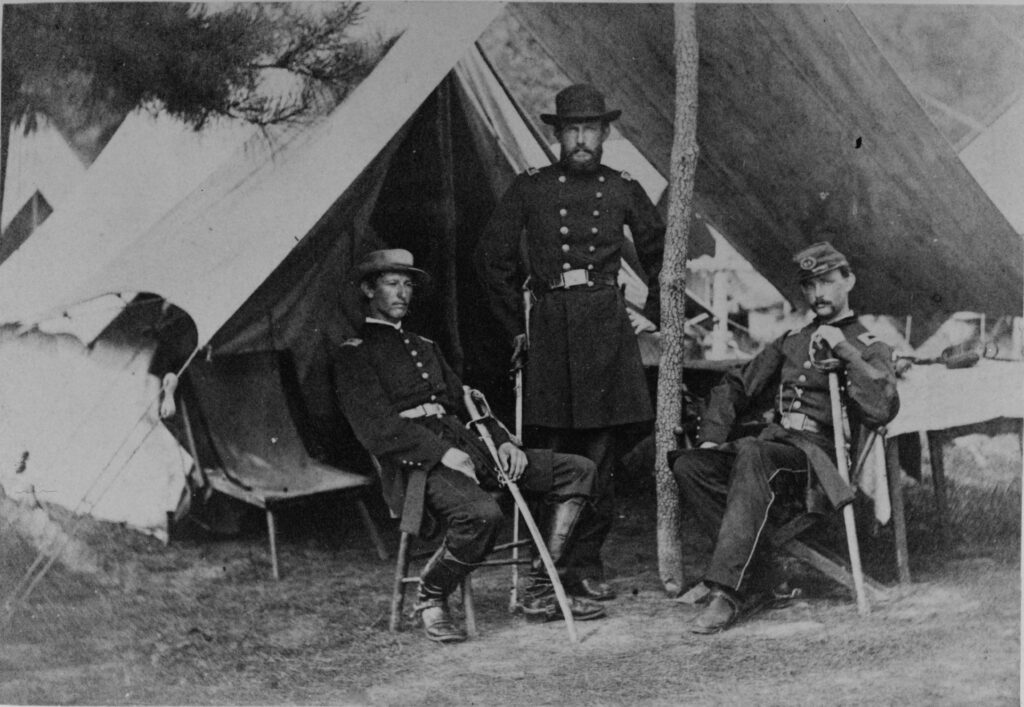
Myer would spend the last few months of 1862 and the first few months of 1863 getting a new bill passed for the Signal Corps. Additionally, he reopened the Georgetown camp in Dec. 1862. Up until now, Myer was the only Signal Officer in the Army; everybody else was on detail duty and did not have commissions as Signal Officers. Myer’s bill got passed in March 1863. It established a Signal Corps with a colonel as its chief officer. On April 29, 1863, Myer would be promoted to Col. and Chief Signal Officer of the Army. Myer organized the Signal Corps under its expanded legislation from April to November 1863. Myer established a board to examine officers for the Signal Corps. Additionally, they examined all officers on active signal duty to give them appropriate rank. Lastly, this bill allowed Myer to recruit directly. He was no longer reliant on the detail system that had plagued him since the beginning of the war. Also during this time, Myer invented and perfected the cipher disk that would remain in use for the rest of the war.
During the months of 1863 that Myer was in Washington, the argument over control of the electric telegraph boiled over. Up to this point, the Military Telegraph Corps had been operating all the permanent telegraph lines. Control of field telegraphs was blurred; some of them were controlled by the Signal Corps, others by the Military Telegraph Corps. On November 10, 1863, Myer was ordered to the War Department to meet with Secretary of War Edwin Stanton. After this meeting, Myer was dismissed from his position as Chief Signal Officer and was ordered to report to Memphis, TN. Additionally, Stanton put all telegraphs under the control of the Military Telegraph Corps. This was the end of a long-standing feud between the Signal Corps and the Military Telegraph Corps. Myer thought that the telegraph should be under his control as it was a method of signaling. The head of the Military Telegraph Corps, Col. Anson Stager, thought otherwise.
When Myer arrived in Memphis, he made a report on a line of signal stations from Memphis to Cairo, IL. While in this position, Myer worked on A Manual of Signals for Signal Officers in the Field, a general service manual for signal officers. The first edition was published in 1864. In May 1864, Gen. Canby, the same officer that Myer tested his signals in New Mexico under, assigned Myer to be the Chief Signal Officer of the military division of West Mississippi. While in this position, Myer developed the General Service Code, a revised signal code that allowed the Navy and Army to communicate with each other. This would be the last contribution of Myer to the Civil War. Myer was informed in August 1864 that the Senate had failed to confirm his appointment as a Colonel and as Chief Signal Officer of the Army. Sec. of War Stanton never submitted Myer’s name and appointment to the Senate. Myer would see no more active duty during the Civil War.
Post-Civil War Career and Life
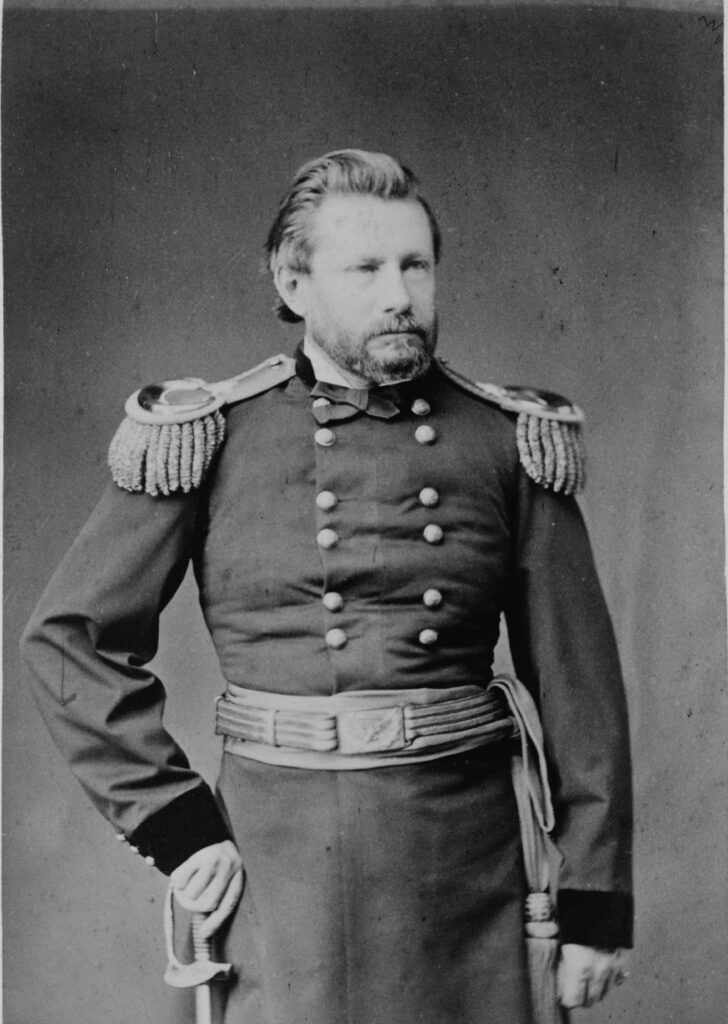
After his dismissal, Myer would return to his family’s home in Lakeview, NY, just south of Buffalo. For the rest of 1864, 1865, and most of 1866, Myer tried to get his position back and name cleared. In October 1866, President Andrew Johnson ordered Stanton to reappoint Myer. Myer built up the peacetime Signal Corps. He established a Signal Corps training camp at Ft. Whipple, VA. In 1872, the military telegraph lines were put under control of the Signal Corps. The Signal Corps helped establish the United States Weather Service. Myer was interested in predicting the weather using telegraphs. To do this, he would have military posts to the west report what their weather conditions were. Myer would use this to predict what the forecast for the next few days would be. The weather forecasts were called Probabilities, and this earned Myer the sobriquet of “Old Probabilities.” His interest and prowess in meteorology would make him an international star, and he presented at many conferences in Europe. On June 16, 1880, Myer was promoted to the rank of Brigadier General. Myer would hold the position of Chief Signal Officer until his death on August 24, 1880. His wife and six children survived him. He was buried near the family home in Lakeview. Shortly after his death, Ft. Whipple would be renamed Ft. Myer in his honor.
Major Sources for Biography
Brown, J. Willard. The Signal Corps, USA in the War of the Rebellion. Boston: US Veteran Signal Corps Association, 1896.
Hageman, Mark C. “Albert James Myer (1828~1880): Physician, Surgeon, Signal Corps Founder, Weather Service Founder.” Signal Corps Association, accessed January 7, 2023.
Scheips, Paul Joseph. “Albert James Myer, Founder of the Army Signal Corps: A Biographical Study.” PhD Diss., The American University, 1965.
Notes
Additionally, for a treasure trove of material related to the Signal Corps in the Civil War, please see www.civilwarsignals.org. For conflicting dates in Myer’s life, Scheips’s biography dates were used.
Brian Burtka
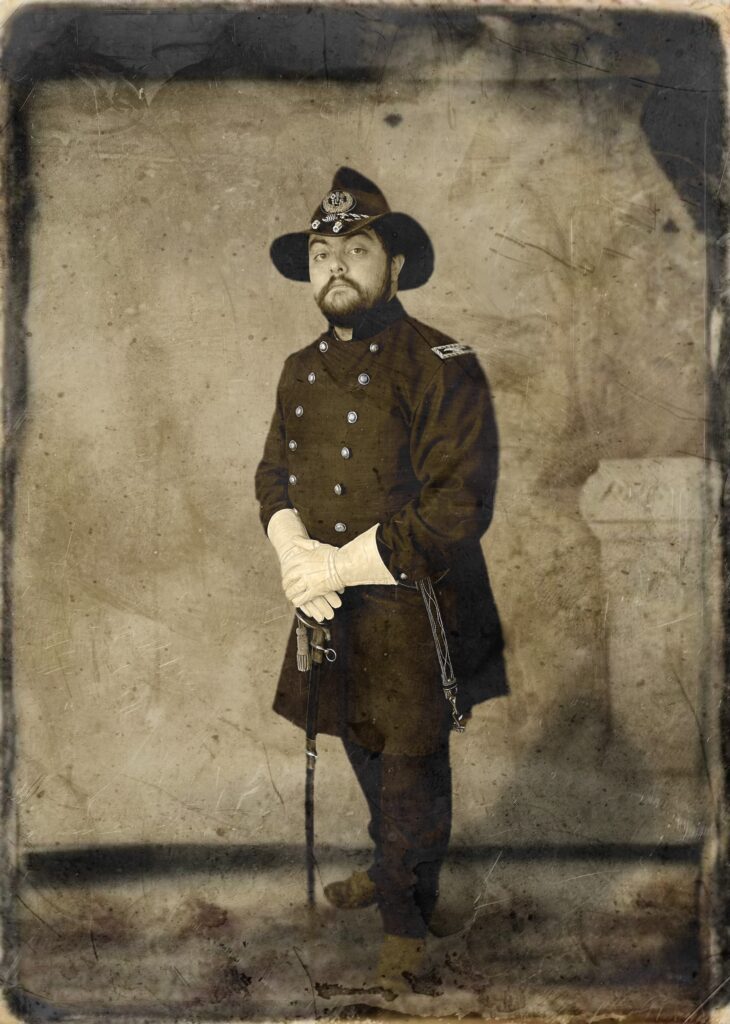
Brian Burtka was born and raised in the Detroit area in Michigan. Currently, he is a graduate student at Loyola University Chicago. He began to reenact in 2013 by joining a Union infantry group. Brian has portrayed infantry, artillery, and the signal corps. His inspiration to portray Col. Albert Myer comes from his interest in the Signal Corps during the Civil War. After doing some reading, he discovered that the Signal Corps was founded during the Civil War by Col. (then Maj.) Myer. He believes that the Signal Corps is an underrepresented area of Civil War living history, and he loves to share his knowledge about it. For more information about Albert Myer, the founding of the Signal Corps, or Signal Corps reenacting and living history, Brian Burtka may be contacted at albert.myer@uniongenerals.org.